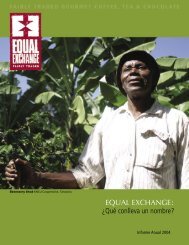a guide to the coffee taster's flavor wheel - Roast Magazine
a guide to the coffee taster's flavor wheel - Roast Magazine
a guide to the coffee taster's flavor wheel - Roast Magazine
You also want an ePaper? Increase the reach of your titles
YUMPU automatically turns print PDFs into web optimized ePapers that Google loves.
A Well-Rounded Palate (continued)terms), none<strong>the</strong>less <strong>the</strong> foundation is solid. It may require morefuture work <strong>to</strong> make it more accessible <strong>to</strong> everyone.After learning that <strong>the</strong> two <strong>to</strong>ols were meant <strong>to</strong> work <strong>to</strong>ge<strong>the</strong>r,I was surprised <strong>to</strong> see that <strong>the</strong>re wasn’t any indication on <strong>the</strong> CoffeeTaster’s Flavor Wheel that one needed <strong>the</strong> handbook <strong>to</strong> interpret<strong>the</strong> imagery. It seems like <strong>the</strong> relationship between <strong>the</strong>se twopieces is recommended as opposed <strong>to</strong> vitally dependent on oneano<strong>the</strong>r.Faults and Taints WheelThe left side of <strong>the</strong> poster refers <strong>to</strong> <strong>the</strong> negative effects on <strong>coffee</strong>through five groups—harvesting/drying, s<strong>to</strong>rage/aging, roasting/caramelization, post-roasting/staling and post-brewing/holding.Basically anything that has gone wrong with a <strong>coffee</strong> would likelyend up on <strong>the</strong> faults and taints <strong>wheel</strong>. As you may have guessed,<strong>coffee</strong> cannot remain in a constant state of equilibrium througheach of <strong>the</strong>se stages, and when things go awry, <strong>the</strong> characteristicsare best described through <strong>the</strong> faults and taints <strong>wheel</strong>. Essentially,this is <strong>the</strong> problem side of <strong>the</strong> Coffee Taster’s Flavor Wheel.According <strong>to</strong> <strong>the</strong> Coffee Cupper’s Handbook, “If <strong>the</strong> change results ina minor <strong>flavor</strong> defect, usually limited <strong>to</strong> <strong>the</strong> aromatic properties of<strong>the</strong> <strong>flavor</strong>, it is referred <strong>to</strong> as a <strong>flavor</strong> taint. Whe<strong>the</strong>r a <strong>flavor</strong> taintis pleasing or displeasing depends on its type and degree, as well as<strong>the</strong> cupper’s personal preference. If <strong>the</strong> chemical change results ina major failing, usually transmitted <strong>to</strong> <strong>the</strong> taste properties of <strong>the</strong><strong>flavor</strong>, it is referred <strong>to</strong> as a <strong>flavor</strong> fault. Flavor faults are almost alwaysdispleasing, regardless of <strong>the</strong> cupper’s personal preference.”AromasAroma (o<strong>the</strong>rwise known as fragrance, nose, aftertaste) is <strong>the</strong>general term used <strong>to</strong> encompass all stages of smelling <strong>coffee</strong> on <strong>the</strong><strong>flavor</strong> <strong>wheel</strong>. The aromas found in <strong>coffee</strong> are experienced through<strong>the</strong> nasal passage, sending a message <strong>to</strong> <strong>the</strong> olfac<strong>to</strong>ry bulb in <strong>the</strong>brain. The cupper <strong>the</strong>n translates this message in<strong>to</strong> a word like“fruity.” When you look at <strong>the</strong> aromas on <strong>the</strong> <strong>flavor</strong> <strong>wheel</strong>, youwill find a general category called “enzymatic,” which is linked<strong>to</strong> <strong>the</strong> “fruity” term. From this point, you have <strong>the</strong> option of twodifferent fruit categories (“citrus” or “berry-like”) and more terms<strong>to</strong> describe different fruit options. You look at <strong>the</strong> <strong>wheel</strong>, dig deepin<strong>to</strong> your memory for <strong>the</strong> aroma you are experiencing, and <strong>the</strong>nwork through <strong>the</strong> possible term <strong>to</strong> match your beliefs. This is how<strong>the</strong> vast majority of cuppers likely use <strong>the</strong> <strong>flavor</strong> <strong>wheel</strong>.However, <strong>the</strong> aroma side of <strong>the</strong> <strong>wheel</strong> lists three primaryterms: “enzymatic,” “sugar browning” and “dry distillation.” Thisis where I started <strong>to</strong> create a few conflicting arguments. I wonderedif <strong>the</strong> <strong>flavor</strong> <strong>wheel</strong> was created as a way <strong>to</strong> evaluate <strong>coffee</strong> in asample cupping or roasted <strong>coffee</strong> in a production cupping. Whencupping samples from our producer partners, we use a light roastand evaluate <strong>the</strong> cup characteristics with <strong>the</strong> SCAA cupping form.All of <strong>the</strong> roast colors are <strong>the</strong> same, however we sometimes finddistinctive aromas like maple syrup or cloves.The Value of Production CuppingThe Coffee Taster’s Flavor Wheeland The Coffee Cupper’s Handbook canprovide insight in<strong>to</strong> <strong>the</strong> way youproduce <strong>coffee</strong> for your cus<strong>to</strong>mers.One of <strong>the</strong> most effective <strong>to</strong>ols is avery basic and old-school methodof analyzing <strong>coffee</strong> roasts througha process known as productioncupping. At Equal Exchange, each daysamples from each batch of roasted<strong>coffee</strong> are brought <strong>to</strong> <strong>the</strong> lab andcupped <strong>the</strong> following morning. Eachsample lists <strong>the</strong> name of <strong>the</strong> <strong>coffee</strong>,degree of roast, colorette numberBeth Ann Caspersen at aproduction cupping.(color spectrometer) and <strong>the</strong> numberpho<strong>to</strong> courtesy of Equal Exchangeof <strong>the</strong> roast for that day. Coffees areorganized by origin and in order of roast degree. Companies do this <strong>to</strong>analyze <strong>the</strong> consistency from roast <strong>to</strong> roast of <strong>the</strong> same origin <strong>coffee</strong> (orblend) and <strong>to</strong> verify/confirm <strong>the</strong> characteristics <strong>the</strong>y want <strong>to</strong> see come ou<strong>to</strong>f a particular <strong>coffee</strong>. Investing in this system requires time, energy andfollow-through, but <strong>the</strong> results can be tremendous.After each cupping is finished, <strong>the</strong> cuppers (both roasters and qualitycontrolfolks) evaluate each of <strong>the</strong> <strong>coffee</strong>s, talk about what <strong>the</strong>y liked,what needs <strong>to</strong> change and how <strong>to</strong> make informed changes. Feedbackand production cupping notes may <strong>the</strong>n be sent <strong>to</strong> <strong>the</strong> purchasing,quality-control and roasting teams each day with <strong>flavor</strong> descriptions andrecommendations.Production cupping every roast creates a solid feedback loop thatincludes everyone in <strong>the</strong> process and builds excitement and sharedresponsibility. It’s also a great way <strong>to</strong> encourage various levels ofexperimentation. If you are not production cupping in your roastery,consider it. It’s a solid investment in <strong>the</strong> quality of your <strong>coffee</strong>.—Beth Ann CaspersenThe ColorsI always thought that <strong>the</strong> colors of <strong>the</strong> <strong>wheel</strong> were attractive andseemed <strong>to</strong> express <strong>the</strong> terms <strong>the</strong>y surrounded—light yellow forlemon, dark brown for chocolate—but what I learned from Linglewas that <strong>the</strong> amount of time and energy put in<strong>to</strong> <strong>the</strong> color schemewas not a whimsical arrangement related <strong>to</strong> terms, but that eachterm was very purposefully put in place <strong>to</strong> represent <strong>the</strong> weight of<strong>the</strong> molecules that <strong>the</strong>y were meant <strong>to</strong> represent. For example, <strong>the</strong>enzymatic category and <strong>the</strong> terms associated with it actually containa lighter molecular weight than those found in <strong>the</strong> dark purplecolors seen in <strong>the</strong> dry distillation category.In addition <strong>to</strong> <strong>the</strong> significant importance of molecular weight,<strong>the</strong> aroma categories also have specific definitions that refer <strong>to</strong><strong>the</strong> way <strong>the</strong> <strong>coffee</strong> was grown, <strong>the</strong> development of sugars in <strong>the</strong>roasting process, and bean fiber. Terms like “<strong>coffee</strong> blossom” in <strong>the</strong>enzymatic category refer <strong>to</strong> <strong>the</strong> development, maturity and terroircontinued on page 4442 roast May | June 2012 43












